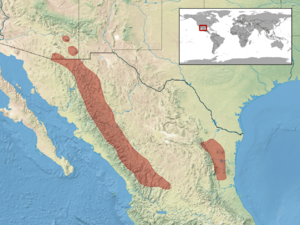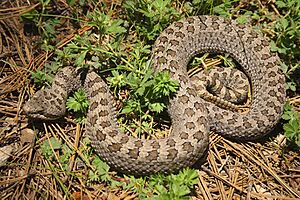Crotalus pricei facts for kids
Quick facts for kids Crotalus pricei |
|
|---|---|
 |
|
| Conservation status | |
| Scientific classification | |
| Genus: |
Crotalus
|
| Species: |
pricei
|
 |
|
| Synonyms | |
|
|
- Common names: twin-spotted rattlesnake, western twin-spotted rattlesnake, more
The twin-spotted rattlesnake (scientific name: Crotalus pricei) is a type of venomous snake. It's a kind of pit viper, which means it has special heat-sensing pits on its face. These pits help it find warm-blooded prey. This snake lives only in the southwestern United States and northern Mexico. There are two different types, or subspecies, of this snake.
Contents
What's in a Name?
The scientific name, pricei, honors a field biologist named William Wightman "Billy" Price. He was the first person to collect specimens of this snake. These specimens helped scientists officially describe the species.
How to Spot a Twin-Spotted Rattlesnake
Adult twin-spotted rattlesnakes are usually not very long. They are typically about 50 to 60 centimeters (around 20 to 24 inches) in total length. The longest one ever recorded was 66 centimeters (26 inches) long.
Their skin color can be gray, bluish-gray, brownish-gray, or even reddish-brown. They often have tiny brown speckles all over their bodies. What makes them special is their pattern of dark spots on their backs. These spots often look like they are split down the middle, forming 39 to 64 pairs of blotches. This unique pattern helps them blend in with their rocky mountain homes.
Snake Behavior and Habits
This small snake lives in rocky mountain areas. Even though it's small, it might rattle loudly if a human gets too close. However, its rattle can be hard to hear among the rocks. The nights where it lives are often cold.
The twin-spotted rattlesnake hunts for food, mainly small rodents and lizards. Its unique pattern helps it hide very well. It blends in with the light and shadows of the mountains. Scientists don't know much about how strong its venom is. There have been no recorded bites to humans from this snake.
Other Names for This Snake
People use several common names for C. pricei. These include:
- twin-spotted rattlesnake
- western twin-spotted rattlesnake
- Price's rattlesnake
- Arizona spotted rattlesnake
- spotted rattlesnake
- Arizona twin-spotted rattlesnake
Where Do They Live?
You can find C. pricei in the United States in southeastern Arizona. In northern Mexico, it lives in the Sierra Madre Occidental mountain range. This includes the states of Sonora, Chihuahua, and Durango. It has also been found in the Sierra Madre Oriental mountains in southeastern Coahuila, Nuevo León, and Tamaulipas. There are also a few records from San Luis Potosí and Aguascalientes. The first place this snake was officially found was in the "Huachuca Mountains, Arizona."
Is This Snake in Danger?
The twin-spotted rattlesnake, C. pricei, is listed as "Least Concern" on the IUCN Red List. This list helps track how threatened different species are. "Least Concern" means that the snake is widespread. It also means there are likely many of them, or their numbers are not dropping quickly. When scientists checked in 2007, the snake's population seemed stable. This means it was not increasing or decreasing.
Types of Twin-Spotted Rattlesnakes
There are two recognized subspecies of the twin-spotted rattlesnake:
| Subspecies | Taxon author | Common name | Geographic range |
|---|---|---|---|
| C. p. miquihuanus | Gloyd, 1940 | Eastern twin-spotted rattlesnake | Mexico: southeastern Coahuila, Nuevo León and Tamaulipas |
| C. p. pricei | Van Denburgh, 1895 | Western twin-spotted rattlesnake | United States: southeastern Arizona, Mexico: Sonora, Chihuahua and Durango |



